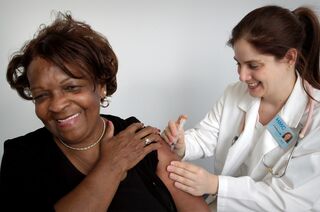Suicide
Should We Brace for a New Wave of Suicides?
Public health guidance on COVID-19 suicide prevention.
Posted May 26, 2020
The COVID-19 pandemic continues to place great strain on the country. However, much of the recent health- and media-related coverage has shifted to an impending ‘second wave’ or spike in ‘deaths of despair’. No matter the moniker, there seems to be traction for the idea that the pandemic will result in a sharp rise in suicide deaths.
Will we experience a rise in suicide deaths? Intuitively and anecdotally, it’s easy to understand why the answer may be ‘yes’. The best answer is that we don’t know.
We found only one study focused on the direct matter of pandemic and suicide, in which H1N1 virus epidemic was weakly correlated with suicides only up to 2 months in the post-epidemic period. Rather than base our opinions on this somewhat limited study, we can find insight by considering other recent catastrophic events. Suicide rates may drop or remain steady after major events like 9/11. Such events are thought to bring us together, thereby enhancing social support or connectedness (a noted public health protective factor for suicide). On the other hand, we may see an increase in recession-related suicide rates; a bevy of basic stressors, such as obtaining basic needs like housing and food, often comes along with economic fallout.
What can we do to prevent suicide?
As we have seen with COVID-19 mortality modeling, predicting an outcome may be less useful than preparing and preventing it. Rather than simply bracing for subsequent ‘waves’ of fallout from COVID-19, we need to shift from the prediction mindset to a preventive one.
We can prevent a rise in suicide and related negative outcomes if we quickly design and enact new policies to support communities and especially vulnerable populations. We can think in terms of the social-ecology of suicide, both during and after the pandemic. A social-ecological take of suicide prevention considers the reduction of risk factors and enhancement of stress-buffering factors at structural, interpersonal, and individual levels.
Creating comprehensive prevention measures is easier said than done. An international team of scholars has provided guidance on where to focus prevention efforts. Of the many factors emphasized, the experts point out that preventive intervention must focus on treating mental illness and suicide specifically. Additionally, strategies must be enacted to reduce financial stressors, domestic violence, alcohol use, loneliness or feeling trapped, and access to lethal suicide means (e.g., firearms). Finally, the team highlights how pivotal responsible media reporting on suicide is, especially during unprecedented times like a pandemic.
To save as many lives as possible, decisions about suicide prevention during this pandemic must be made quickly and based on what knowledge we already have. To guide the conversation about suicide prevention in the time of COVID-19, we’ve outlined several strategies meriting immediate evaluation.
Financial policy-making. A team of United Kingdom researchers provided a roadmap of factors that may impact suicide during times of economic crisis. They highlighted pathways to suicide beginning with the perceived threat of job loss and actual loss (of job, home, etc.) leading to relationship conflict and worsening debt. The financial stresses contribute to poor mental health and coping.
In our time of pandemic and economic loss, we may be tempted to scale down costly societal efforts; however, policymakers should see this as an investment in long-term productivity and stability. We must continue funding welfare, unemployment insurance, and other policies to stem the impacts of job and financial loss. As the U.S. government has passed economic stimulus package support, it remains clear that strong financial supports to individuals, families, and small businesses are vital when placed in suicide prevention terms.
Crisis call center use and funding. As often suggested, the National Lifeline (1-800-273-TALK) or CrisisText (Text “Home” to 741741) provide anonymous professional support to those struggling at any time of day. Strong public health approaches rely on crisis call centers. Interestingly, persons reaching out to call centers are often seeking social support or connection. Federal, state, and county government should act swiftly to ensure staffing and funding support as part of any comprehensive pandemic or economic recession planning. More practical guidance on crisis call centers has also been offered.

Building social connectedness. Everyone should be encouraged to reach out for support in times of need, whether through traditional or creative means. In addition to providing access to call centers and professional health care, we can each take steps to build support and connectedness for our communities. For example, sending caring contacts can help us feel connected. We may send letters or postcards, even electronically, especially to persons we know to be quarantined or otherwise isolated. The American Association of Suicidology of recently launched a unique social connectedness initiative: #SoulCareAAS365. The social media and web-based campaign focuses on relationship building and wellness through a variety of toolkits and approaches.
Identifying opportunities to support ourselves. Although we feel limited by the loss of many comforts of our pre-pandemic lives, a variety of enjoyable activities are still available. Especially as we move into phased re-opening (see here for pleasurable events ideas), we can focus on using what resources are still available. We can continue to take practical de-stressing steps to limit fear and anxiety. Mindfulness shows solid evidence in helping treat conditions such as depression and anxiety. A few free online resources include mindfulness for healthcare professionals and Mindful.org for easy to implement techniques.
Enhancing mental health resources. For those experiencing difficulty with in-person mental healthcare access, many insurance companies recently expanded coverage for telehealth, including teletherapy. Publicly available resources exist to help find affordable therapists via telephone or web access. For health service providers treating patients via distance, crisis response planning for persons experiencing suicidal ideation or other high-risk problems should include the removal of lethal suicide methods like guns. Further valuable telehealth crisis response planning information has been offered.
Enact a directed research agenda immediately. An international, multidisciplinary research group recently put forth a very useful set of COVID-19 specific suicide and mental health research priorities in the Lancet. For example, they advise the evaluation of the most effective ways to raise awareness of resources available for vulnerable populations. They also suggest an investigation of how existing best practice interventions can be repurposed to deal with COVID-19 related matters. Regarding media exposure, research is needed to understand the negative effects of overconsumption as well as robust methods to reduce consumption. Finally, we must understand how mental and public health messaging can promote the public’s adherence to healthy behaviors (e.g., physical distancing).

Focus on high-risk groups. We acknowledge — everyone’s mental and overall health is worthy of attention. It’s unrealistic, however, that we could ever fully address each at-risk group here. Story after story suggests vulnerable groups will endure the most extreme mental health and suicide-related outcomes of COVID-19. The authors of the Lancet guidelines suggest we focus on vulnerable populations such as:
- Frontline healthcare professionals exposed to daily trauma, especially during crises;
- Persons with pre-existing mental illness who may lose traditional coping strategies;
- Older adults, especially those in long-term care facilities, and otherwise stigmatized groups (e.g., incarcerated persons) who may have their sense of social isolation and perceived burdensomeness heightened because of additional social or placement restrictions resulting from COVID-19.
Also, we add the need to attend to the needs of...
- International and first-generation students who may experience increased prejudice and hate crimes during a time where political discourse promotes prejudice and educational closures layer on economic and familial stressors.
The coronavirus poses economic, health, and other challenges for us all. Suicide is certainly a pressing matter within the discussion. We are all in the suicide prevention effort together. Stay connected, support others, share helpful resources, and advocate for smart public discourse and policy.
Co-authors of this post:
Susanna Harris, Ph.D., a science communicator who just recently defended her dissertation at the University of North Carolina in Microbiology and Immunology. She founded PhD Balance to promote inclusion, equity, and student wellness in academia. Learn more at her website.
Jagdish Khubchandani, Ph.D., MPH, MBBS is a professor in the Department of Nutrition and Health Science at Ball State University.




